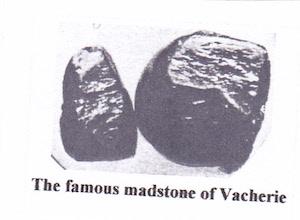May 17, 2023 - One of the most intriguing artifacts held in the collection of the Sam Houston Memorial Museum is a “mad stone” donated to the Museum in 1978. The question is, “What is a mad stone, and how was it used?”
In the 1890s, mad stones were widely used in East Texas for the treatment of rabies. These small stones were occasionally found in the stomach of wild animals, especially deer. They were akin to bezoars which consisted of a collection of calcified hair and other debris in the stomach. The best grade of mad stone came from a white or spotted deer, supposedly working better than a stone from a brown deer.

These little stones came in various shapes and colors, and were believed to have therapeutic properties, as well as spiritual power. People, often children, bitten by mad dogs, cats, foxes, squirrels, cows, horses, and other animals were brought hundreds of miles to use them.
In East Texas there were “resident” mad stones in Houston, Dallas, Plano, Corsicana, Denison, Kaufman, and a few other towns. These stones were owned and used by medical doctors, preachers, policemen, as well as private citizens. The famous Kaufman stone was kept, of all places, at the county treasurer’s office.
One mad stone was described as being small, flat, and of a dark gray color like slate. Another was irregular in shape, dark brown, and porous. One of the Georgetown stones was said to be about the size of a small hen egg with one end cut smooth away. Still another mad stone looked just like a chunk of common coal.
Well into the first part of the 20th century, the only treatment for somebody bitten by a “mad” animal was believed to be the application of a mad stone. The treatment process was rather simple. The mad stone was first heated in a container filled with sweet milk. Then it was applied to the area where the victim had been bitten. If the stone adhered to the skin, this was a good sign, and recovery was thought possible. Sometimes the stone would cling to the skin for only a few minutes; in other cases up to six hours. During this time, the patient would often walk the floor in pain.
When the mad stone did come loose from the skin, it was immediately dropped back into the container of warm milk. If a slimy, green substance appeared on the surface, it was believed this was the poison that had been extracted from the patient. If no tell-tale poison was observed, the wound was re-opened, the stone again cleansed in the milk, and the process repeated until the desired results were obtained.
Many rural doctors administered the mad stone treatment as part of their regular medical practice. Preachers, who owned mad stones, often applied them in an atmosphere of spiritual faith, fervently praying the stone would be used of God to heal the unfortunate person. Many of the best known mad stones had impressive histories, credited over the years to have been used to save the lives of hundreds of people infected with rabies.
Texas newspapers of the 1890s are filled with detailed accounts of cases where people bitten by rabid animals were apparently “cured” by the application of a mad stone. However, whether it was actually the stone themselves, or simply the peoples’ faith that gave hope and brought about the recoveries will forever remain a point of conjecture.
As an aside, have you ever wondered where the term “Dog Days” came from? They were originally called “mad dog days”. These are the hot summer days of August and September when rabies infection among dogs and other animals was at its highest. The mad stone practitioners must have really gotten a workout during this time of the year.
As for me, if I was bitten by an animal with rabies, the only way they would ever stick a mad stone on me would be as I was lying on the emergency room table, unconscious, while getting shots in the stomach. But, back in the day there were few doctors in the territory, and doing anything was better than doing nothing, I suppose.









